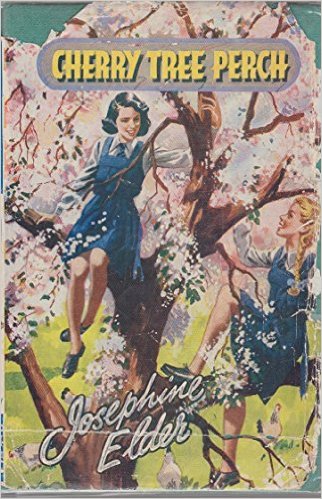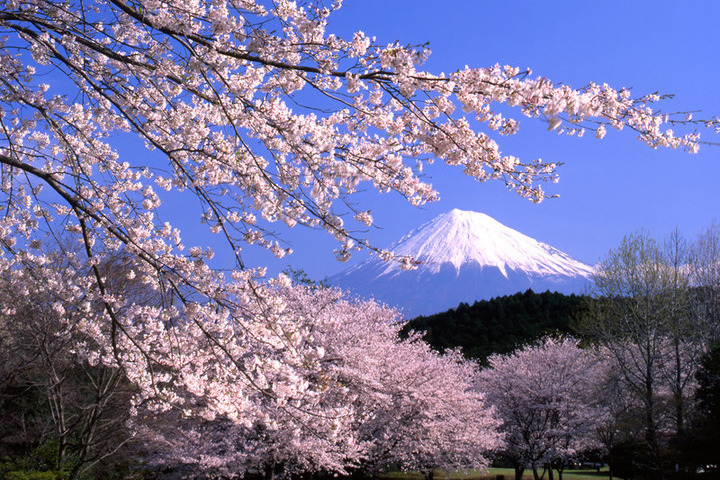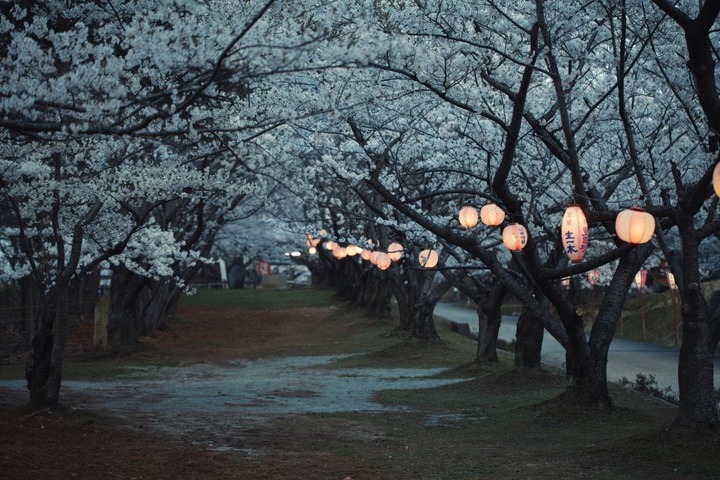WILD CHERRIES, CHERRIES THAT LIGHT UP THE CITY, SALT-PICKLED CHERRY BLOSSOMS
 Fallen cherry blossom, Richmond Park
Fallen cherry blossom, Richmond Park
Cherry blossom in spring never fails to tug at our heartstrings. We are moved by the fragile mosaic of fallen petals on the grass and exhilarated by the sight of pale blooms against a brilliant spring sky:
 Yoshino Cherry against sky, Batsford Arboretum , Gloucestershire
Yoshino Cherry against sky, Batsford Arboretum , Gloucestershire
Sitting stuck in traffic at a noisy junction at Vauxhall Cross I am distracted by two elegant white-flowered cherry trees which spread out their branches at the base of the movie-set-weary MI6 building and exert a self-contained, civilising influence over this grimy corner of the city. A little further south, the looming steak and curry-night posters outside the pub on Denmark Hill are masked for a few weeks by the intense blooming of a pair of cherry trees, one pink and one white.
I look up ‘cherry tree’ on Amazon – the titles are infused with nostalgia: the fresh delight of spring, the poignant passing of time. I smile at the cover of Josephine Elder’s 1954 ‘Cherry Tree Perch’. It is an impossible cover for a 2016 teenager, but there is a timeless element too – the beginning of the summer term, escaping from revision, dreaming about the time when school is over for the summer.

And Enid Blyton does not miss a trick when she locates a set of young heroes in the idyllic and comforting world of ‘Cherry Tree Farm’:

I confess we followed the same path when we asked our friend the portrait painter, Paco Garcia, to paint our three young sons. We were powerfully drawn to the idea of placing the boys under the ‘Great White’ cherry tree – Prunus ‘Tai-Haku’ – at my husband’s family farm in Suffolk.

Prunus ‘Tai-Haku’ in the middle of the lawn, Suffolk
 Portrait of our three sons by Paco Garcia, spring 2003
Portrait of our three sons by Paco Garcia, spring 2003
The tree was planted forty years ago in the middle of the lawn nearest to the terrace. As well as its dazzling spring display, this tree has been a key player in family life for decades. It has provided shade at teatime when it is hot, it has been the place to put your new baby in his pram to gaze up at the gentle semaphore of the waving branches against the clouds, it was where the grandsons, when they were bigger, tumbled about on the petal-strewn grass with their grandfather’s new puppies. It was even – rather magnificently – incorporated in full flower into the 21st birthday marquee of my sister in law.
But this year, the cherry blossom in the UK has kept us waiting. Gardens with notable collections of cherry trees such as Batsford Arboretum and Kew Gardens invite visitors to telephone for updates. Each time I call, the recommended start date for a satisfactory blossom viewing is nudged a little later. The British approach is rather more gentle than the high-powered Cherry Blossom Watch in Washington DC – a city famed for its spectacular cherry blossom for over a century. In Washington, peak cherry blossom bloom is when the trees are exactly 70% out. Accurate forecasts and guidance are available for visitors and if you are still hopeful of catching some blossom, I’m afraid I have bad news. “Are DC’s Cherry Blossoms blooming?”, I want to know on April 27th, “No, they’re done for the year” declares the website. “The cherry blossoms reached peak bloom on March 25 2016”.

Back in London there is a moment at the end of March when entire London streets revel in their pale pink canopies of the particularly early flowering cherry plum, Prunus cerasifera ‘Pissardii’:


 Prunus cerasifera ‘Pissardii’ – Holland Park, London
Prunus cerasifera ‘Pissardii’ – Holland Park, London
But there is a downside to this exuberant beginning – when the blossom floats away, the trees’ brownish-purple leaves give them a heavy, rather sulky look.
Down the hill in Ladbroke Grove, Chesterton Road is lined entirely with cherry trees, but even in the second week of April they are tightly in bud. I have to confess I am slightly hoping that the trees will be pink to match so many of the houses:

 Cherry trees in Chesterton Road, tightly in bud
Cherry trees in Chesterton Road, tightly in bud
When I return on the gloomiest of spring days a couple of weeks’ later, the cherry trees are happily all in flower. They are not pink at all: instead they are lovely, clean, white-flowered Prunus avium ‘Plena’ – the more formal, double version of our native wild cherry. The street is softened by this haze of blossom as far as the eye can see.


 Prunus avium ‘Plena’ in flower, Chesterton Road, London
Prunus avium ‘Plena’ in flower, Chesterton Road, London
In a neighbouring street I catch sight of a little and large version of Prunus avium ‘Plena’ outside a pair of handsome Victorian houses. I love the balance of green and white against terracotta and green and white against white stucco, and it must be lovely to walk under a bower of pendulous blossom on your way to your front door. But there is a serious size issue to be considered when planting a dainty young cherry tree in your front garden. Too many trees – I am now rather obsessively observing them from my car and from the bus – were always destined to become too big for their site: they have become too heavy and have been chopped about in an attempt to squeeze them into the available space.


 Prunus avium ‘Plena’ – against terracotta and white painted stucco
Prunus avium ‘Plena’ – against terracotta and white painted stucco
On a more gorgeous day in a less lovely street in South London, indeed on the pavement alongside a railway, a row of fastigiate street cherries – I think they are the popular Prunus ‘Amanogawa’ – makes every passer by smile.

 Railway-side cherry trees, Peckham
Railway-side cherry trees, Peckham
I love the added bonus of the trees’ elongated shadows on the tarmac: Cherry tree with elongated shadow
Cherry tree with elongated shadow
And looking up, the combination of palest pink flowers against a rich blue sky is exhilarating:

 Cherry blossom against blue sky, South London
Cherry blossom against blue sky, South London
As I wait for the right moment to head out of town I think about Japan, a country synonymous with cherry blossom.
The world of Japanese ‘hanami’ (flower viewing) is I am sure very beautiful, in parts. If you research it even for a moment you will be bombarded with extraordinary images of ‘sakura’ (cherry blossom) with Mount Fuji beyond, or of ‘night sakura’ or ‘yozakura’ when the cherry trees are hung with paper lanterns:

 Cherry blossom with Mount Fuji and ‘night sakura’ from the excellent blogpost ‘Insider Journeys’ by Rachel McCombie
Cherry blossom with Mount Fuji and ‘night sakura’ from the excellent blogpost ‘Insider Journeys’ by Rachel McCombie
Picnicking under the cherry blossom has unsurprisingly become big business, however, and websites such as Japan Monthly Web Magazine are happy to explain ‘How to Hanami’. The ‘must have’ shopping list includes ‘a typical plastic picnic sheet’, ‘more garbage bags than you think you will need’ and two types of ‘disposable body warmers’ – one is hand held and the other has adhesive so you can ‘tape it to your underwear to keep your back warm’.
Of course even McDonald’s has a special hanami menu – a teriyaki glazed pork patty with cherry blossom flavoured mayo in a pale pink bun and an outrageous looking Sakura Cherry Float to wash it down:

McDonald’s Hanami burger – image courtesy of the cheery blog EATAKU
McDonald’s Sakura Cherry Float – image courtesy of http://www.mcdonalds.co.jp
I know of course there are deeply beautiful, gentler ways to visit Japan at this time of year and I would head there like a shot. This seductive post from Gardenista, which shows how forager Louesa Roebuck pickles cherry blossom, brings the tempo back down to a subtle, delicate celebration of this fleeting moment in spring.
 How to pickle cherry blossoms – photograph from a series by Chloe Aftel on Gardenista
How to pickle cherry blossoms – photograph from a series by Chloe Aftel on Gardenista
It is the third week of April and I can wait no longer for an expedition to see cherry trees growing in the countryside. My plan is to drive to Batsford Arboretum in Gloucestershire (which holds a national collection of cherries) via the Chilterns where I will look first for the wild cherry, Prunus avium.
I am inspired by Richard Mabey’s description of wild cherries in his ‘Flora Britannica Book of Spring Flowers’. He writes that ‘the wild cherry is arguably the most seasonally ornamental of our native woodland trees. The drifts of delicate white blossom are often out in early April, just before the leaves, while in Autumn its leaves turn a fiery mix of yellow and crimson. Even the bark – peeling to reveal dark, shiny-red patches – is extravagantly colourful for a British tree.’ In the Chilterns, when the trees ‘are at the edges of woods, as they often are (cherry needs light to regenerate), they can make the entire wood seem to be ringed with white at blossom-time. A couple of weeks later, when the flowers have fallen, the woods are ringed again, on the ground. After the great storms of October 1987 there was another cherry delight the following spring: windblown trees blooming horizontally in the woods, like flowering hedges.’

Trying to research the best Chilterns woodland to aim for I am distracted by a wave of images of the American funk rock band, Wild Cherry. I fail hopelessly to get the band’s 1976 hit ‘Play that Funky Music’ out of my head as I make my way West on the M40.

But it is has been so cold that the only tree that is lighting up Ibstone Common when I arrive is still the delicate blackthorn or sloe, Prunus spinosa:


 Prunus spinosa, Ibstone Common
Prunus spinosa, Ibstone Common
I find a single, skinny wild cherry, just in flower, under a canopy of taller trees at the edge of the path:

 First wild cherry sighting, Ibstone Common
First wild cherry sighting, Ibstone Common
As I drive on I catch sight of further trees loosely radiant with flower. They have always found their way to the sunniest spots – not least the edges of motorways. At this rate the wild cherry will be with us well into May.

 Wild cherry – Prunus avium – in full flower, in the sunshine, at the edge of woodland
Wild cherry – Prunus avium – in full flower, in the sunshine, at the edge of woodland
By the time I reach Batsford Arboretum the sun is warm enough to have lunch outside and it finally feels like spring. I set off hopefully around the 55 acre grounds. One of the first cherries I admire is this Prunus ‘Pink Shell – I like its rather startling top-heavy stance and its delicate bell-like flowers. Matthew Hall, Batsford’s Head Gardener, tells me that ‘Pink Shell’ is “not well enough known” and “never planted enough”. If you have the space to let it spread out in this exuberant way, you could source one from the nursery there.
 Prunus ‘Pink Shell’, Batsford Arboretum
Prunus ‘Pink Shell’, Batsford Arboretum
Also recommended by Matthew – and indeed on nearly every expert’s list of recommended cherry trees – is Prunus x yedoensis, the Yoshino Cherry. This is another cherry that grows in a lovely open way with profuse, palest pink, almond-scented blossom. In a large, meandering garden such as this, the Yoshino Cherry has the sort of fresh intensity that catches your eye from a distance and draws you towards it.


 Yoshino Cherry, Batsford Arboretum
Yoshino Cherry, Batsford Arboretum
A little further on I come across an elegant group of three young Prunus incisa ‘Fujima’. ‘Fujima’ is a wonderful cherry for smaller gardens – described by nurseries as a large shrub or small tree – with prolific palest pink blossom and handsome red and orange autumn colour once established. Prunus incisa ‘Kojo-No-Mai’ would be a great alternative for a small space. If you have a slightly larger space you could of course follow this example and plant three together.

 A group of three Prunus incisa ‘Fujima’, Batsford Arboretum
A group of three Prunus incisa ‘Fujima’, Batsford Arboretum
An even smaller tree is Prunus ‘The Bride’ with very pretty tight pink buds that open to white. The trees I see planted out and in the nursery at Batsford are very young indeed. I wonder if they will always look a little congested or if they will relax as they grow into a softer shape? I am undecided but the flowers are so charming it could be well worth a try.
 Buds and flowers of Prunus ‘The Bride’
Buds and flowers of Prunus ‘The Bride’
I make my way past a disconcertingly handsome mature Prunus cerasifera ‘Pissardii’. My general view of this purple leaved plum, of course, is that it can only disappoint once the flowers are over, but growing a tree well and giving a tree enough space can make all the difference, I tell myself.
 Handsome, spreading Prunus cerasifera ‘Pissardii’, Batsford Arboretum
Handsome, spreading Prunus cerasifera ‘Pissardii’, Batsford Arboretum
And then I come across a cherry tree which makes my heart sing. In fact there are a pair of them – Prunus ‘Hillier’ – planted together. Each has been given room to grow old in a wonderful, slightly bent, gorgeously layered way. The towering cherries add a pale, fluttering lightness to the mature trees which surround them.

 Prunus ‘Hillieri’, Batsford Arboretum
Prunus ‘Hillieri’, Batsford Arboretum
They perfectly frame the view beyond and I love the way the hanging branches act as the loveliest of veils.
 A pair of Prunus ‘Hillier’ framing the view beyond
A pair of Prunus ‘Hillier’ framing the view beyond


 Hanging branches of Prunus ‘Hillieri’, Batsford Arboretum
Hanging branches of Prunus ‘Hillieri’, Batsford Arboretum
Frustratingly I cannot find a current supplier for Prunus ‘Hillieri’. Matthew Hall at Batsford kindly suggests Prunus ‘Jaqueline’ as his first choice for a possible alternative. ‘Jaqueline’ is a relatively new introduction with deeper pink single flowers. A probable hybrid of Prunus sargentii, it has the bonus of dramatic pink-red autumn colour.
I look again at the two fine ‘Hillieri’ cherries trying to work out what else it is about the planting that is so satisfying. My eye is drawn to the handsome, katsura tree – Cercidiphylum japonicum – standing next to them. This has long been one of my favourite trees with its fine rows of suspended, light-catching leaves which smell deliciously of of burnt caramel in the autumn. It is clearly the absolutely perfect pairing with a shell pink flowered cherry and one I will aim to repeat.  The elegant dirty gold leaves of Cercidiphyllum japonicum
The elegant dirty gold leaves of Cercidiphyllum japonicum


 Cercidiphyllum japonicum and Prunus ‘Hillieri’
Cercidiphyllum japonicum and Prunus ‘Hillieri’





















































